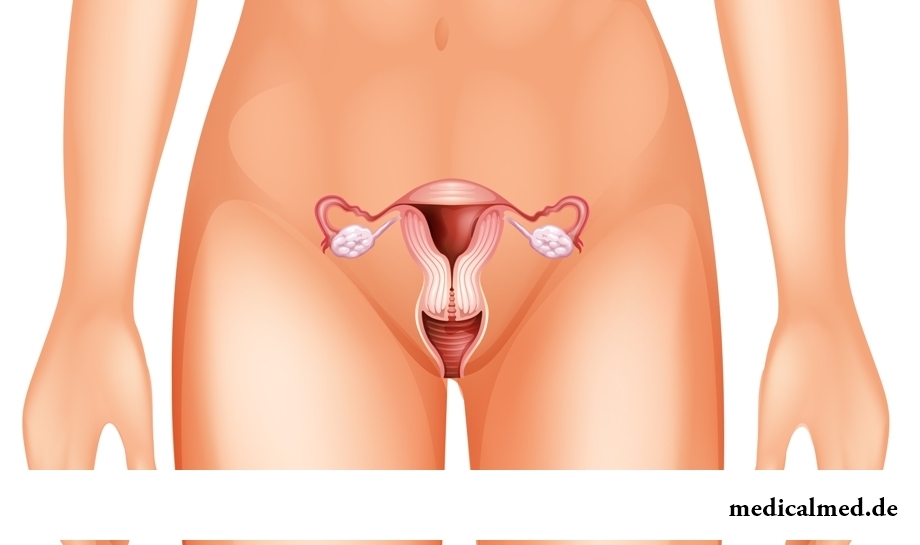





Vagina
The vagina represents elastic and muscular tubular education and is internal generative women's organ.

Vagina structure
The vagina is located in a cavity of a small pelvis. Ahead from it there are a bladder and an urethra, and behind the rectum adjoins to it. From above the vagina covers a neck of uterus, from below it opens vaginal opening in anticipation of a vagina. At virgins the entrance to a vagina is closed by a hymen. Back and front walls of a vagina adjoin with each other therefore the internal cavity of a vagina has the slit-like form.
During sexual intercourse the vagina is the penis receiver, in it the seed gathers, and at the time of delivery it acts as a parturient canal through which after completion of the pre-natal development the fruit comes from a cavity of the uterus to light.
Thickness of walls of a vagina makes 3-4 mm, and its length – from 7 to 12 cm.
Allocate a lobby, back and two sidewalls of a vagina. They consist of several layers:
- The inside layer – is presented by the mucous membrane forming numerous folds.
- The center – is formed by unstriated muscles. The majority of muscle bundles are oriented longwise, but there are also bunches with a circular arrangement. In a lower part of a vagina muscle bundles densely intertwine with crotch muscles, and from above pass directly into uterine muscles.
- The outside (adventitious) layer consists of fibers of connecting fabric.
Vagina at pregnancy
At pregnancy in an organism of the woman there is a hormonal reorganization that leads to changes from connecting and muscular tissue of a vagina. Blood supply of walls of a vagina increases therefore they get a bluish (cyanochroic) shade.
The vagina epithelium at pregnancy is thickened, and also processes of its exfoliating amplify. It promotes increase in number of allocations from a vagina.
Changes in a vagina at pregnancy lead also to change of its microbic flora. Therefore at pregnant women mycoplasmal and barmy colpitises quite often develop.
Vagina diseases
Inflammatory diseases of a vagina – colpitises (vaginit) are quite frequent reason of the address of women to the gynecologist. Most often infections sexually transmitted are the reason of vaginit. In addition the inflammation can be caused by microorganisms or mushrooms which constantly are present at a vagina cavity. With age in an organism of women production of estrogen decreases that can also lead to development of the colpitis called by atrophic.
At a colpitis of the woman show complaints: burning in a vagina and emergence of allocations from it. At an inflammation of the vagina caused by gonokokka, purulent discharges, chartreuse color, and on a consistence remind dense cream. At emergence of burning and fetid yellowish-brown or greenish-white foamy allocations it is possible to suspect a mecotic colpitis of a vagina. Allocations from a vagina at a bacterial vaginosis have a slight smell of crude fish. If the vaginitis is caused by barmy fungi of the sort Candida, then women note an itch in a vagina and emergence of white curdled allocations. Precisely to define a type of the activator which caused diseases and to appoint full treatment, the doctor takes from the woman analyses (a smear, bacteriological crops with sensitivity to antibiotics).
Itch in a vagina
Practically each adult woman is familiar with such problem as an itch in a vagina. The following factors can lead to its emergence:
- Overheating or overcooling;
- Wearing very close or rough underwear;
- Various irritating environmental factors;
- Psychogenic factors (stress, fear);
- Reception of some medicines.
Some diseases can become the itch reason in a vagina also: hypothyroidism, hyperthyroidism, lymphogranulomatosis, leukosis, iron deficiency anemia, renal failure, hepatitises, diabetes mellitus. Therefore if the itch in a vagina proceeds for several days, then it is necessary to see a doctor surely.
The educated person is less subject to brain diseases. Intellectual activity promotes formation of the additional fabric compensating sick.

Modern footwear is extremely various. It stopped being only protection for legs long ago. Today shoes, boots, barefoot persons in...
Section: Articles about health
No, probably, the person who would not have cold. Cold, cough, a headache – these symptoms are known to everyone. The peak of catarrhal diseases is the share of fall. SARS already came to schools and kindergartens, flu slowly makes the way to the cities, in a word, з...
Section: Articles about health
Stroke (acute disorder of cerebral circulation) – one of the most widespread neurologic diseases. Annually in the world more than 6 million people die of this illness. From the survived patients about 80% become disabled people, and nearly a third from them needs afterwards permanent care. In fact, the stroke creates a situation at which a part of cells of a brain loses blood access, loses an opportunity to receive oxygen and nutrients, and perishes. As a result of a razviv...
Section: Articles about health
Cystitis, or inflammation of a mucous membrane of a bladder, this very widespread disease, which, owing to some persons...
Section: Articles about health
Run - one of the most available and effective ways to revitalize the organism. Knowing about its extraordinary advantage, each of us at least once tried to make jogs, but only the few made these occupations regular. In spite of the fact that in jogging (easy an ozdor...
Section: Articles about health
Bees – really unique beings. Practically all products of their life activity are used by the person. Since the most ancient times medicinal properties of honey and other substances received in the course of beekeeping are known. The fact that all these products are recognized not only national, but also official medicine is especially significant. About influence and routes of administration of bee "drugs" the speech in this article will also go....
Section: Articles about health
Antibiotics - - it is possible to call the chemical compounds suppressing growth of bacteria the break in the field of medicine which allowed to save persons...
Section: Articles about health
Shops of household appliances offer us the huge choice of various devices for the house. Whether there are among this abundance devices which not only facilitate house work, but also help to keep health of the person? Of course, and we will tell about them today....
Section: Articles about health
Aspirin (acetylsalicylic acid) – one of those drugs which are known literally to all. It is available in each home first-aid kit, and many accept it at the first signs of an indisposition, often without having a fair idea of properties and therapeutic effect of drug. Meanwhile, impact of aspirin on a human body is very various, and is not always favorable. About it it is important to foreknow, in order to avoid emergence of problems with health....
Section: Articles about health
Statistically, at the address to doctors seven of each ten patients complain of a headache. Actually people, periodically...
Section: Articles about health
"Epilepsy" doctors made the diagnosis in antique times. Displays of an illness and pattern of its development are very well studied. However for nonspecialists this disease remains to not less mysterious, than in the ancient time. Many delusions are connected with epilepsy...
Section: Articles about health
Bathing in broths of medical flowers and plants (phytobathtub) was eurysynusic since Cleopatra who is a good judge in all that concerns beauty and health. And today phytobathtubs is the simple and available means allowing not only to remove nervous tension, but also to recover from many diseases. Grass bathtubs at treatment of cold, osteochondrosis, radiculitis, skin diseases, and also diseases of urinary tract and vessels are especially effective....
Section: Articles about health
80% of women at least once to lives complained of discomfortable feelings to breasts, consolidations and nagrubaniye. These are mastopathy symptoms. The mastopathy is characterized by change of a ratio between ferruterous and connective tissue tissues of mammary glands. It can lead to formation of cysts (a cystous mastopathy), gland consolidation (a fibrous mastopathy), or a combination of these processes (a fibrous and cystous mastopathy)....
Section: Articles about health
Osteoporosis this general disease which main sign is decrease in density of a bone tissue. On width распростран...
Section: Articles about health
Popular joke that there are no healthy people, and is nedoobsledovanny, most of us considers an honest truth, continually it is necessary to hear that all of us are sick hardly from a school bench. It is hard to say, whether so it actually because...
Section: Articles about health
Each woman has preferences in the field of use of those goods which help us to look good, feel young and effective. Besides: selection process of favourite perfume, shampoo or decorative cosmetics already lightens the mood and serves as a peculiar stress medicine. Happens very offensively when the acquired perfumery and cosmetic products not only do not meet our expectations, but also becomes the reason of problems with health. Sources неприятн...
Section: Articles about health
Smack in a mouth can arise in the natural way – as a result of lack of morning hygiene or reception of the corresponding food. Odn...
Section: Articles about health
The next flu epidemic leads to the next panic, from year to year we give in on these manipulations: professionally alarming voice of the announcer in news, reports with calculation of the died patients, an interview with people in white dressing gowns and advertizing of anti-influenza means ра...
Section: Articles about health
Statistically, pathologies of a thyroid gland in the world more than 500 million people have. Failures in work of this body lead to heavy disbolism, development of heart diseases, vessels, a reproductive and nervous system. In hard cases excess or insufficient production of the main hormones of a thyroid gland (thyroxine and triiodothyronine) leads to essential decline in quality of life and disability....
Section: Articles about health
Partial and the more so full loss of hearing significantly reduces quality of life. Difficulties with communication lead to loneliness and замкн...
Section: Articles about health
Producers of milk mixes for children assure: mixes are ideally balanced and adapted for needs of babies. If mother should raise artificially the kid owing to serious problems with health, to do nothing – m substitutes...
Section: Articles about health
Any of us is not insured from a heavy illness of the loved one. Happens and so that someone from family members becomes the bed patient, and remains in such state for a long time. It extremely suppresses both the most injured, and all its house which life considerably changes....
Section: Articles about health
Season of activity of viral infections in the heat. Everyone can get sick, but probability of this unpleasant event it is possible and it is necessary miny...
Section: Articles about health
The healthy nutrition is the invariable principle of health and good health for long years of the woman. Nevertheless, in a diet at each stage of life there are the features allowing to support an organism by those substances which are most necessary...
Section: Articles about health
Today about 30 diseases, sexually transmitted are known. Wide circulation of these illnesses is extremely promoted by the dual attitude towards them: on the one hand, most of people know about "shameful" diseases very little and do not aim at receiving detailed and reliable information, considering that such problems personally will never concern them. With another – there are delusions about STD which instill unreasonable confidence that troubles such...
Section: Articles about health


